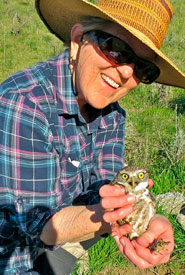What makes burrowing owl volunteers hoot?
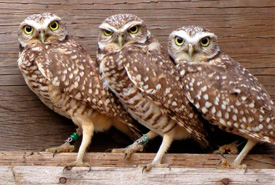
Burrowing Owls gaze at volunteers at Burrowing Owl Conservation Society Breeding Facility near Oliver, BC (Photo by Dianne Bersea)
It’s a cold, early March day when my friend and regular Burrowing Owl Conservation Society volunteer, Doreen Olson, asks me, “Why don’t you join me next time I’m feeding the burrowing owls?”
The following Tuesday finds me at the burrowing owl breeding facility in Oliver, British Columbia, surrounded by dozens of undeniably cute, diminutive buff-coloured owls with round, yellow eyes watching my every move.
“Here, take these buckets and follow me,” Doreen instructs. In minutes I am down on my knees, bum in the air, checking and cleaning the below-ground burrows. I pull the two buckets along to retrieve and sort the remainder of previous meals, found in the burrows, into what can be added to today’s menu.
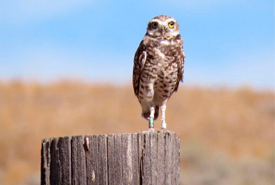
A burrowing owl keeps an eye on volunteers on the Sage and Sparrow Conservation Area in the South Okanagan, BC (Photo by Dianne Bersea)
During this phase of their new lives, the owls are overfed to assure good health, hence the sometimes rather unpleasant remains of their meals. Despite that, I enjoy being in the fresh air, contributing to a unique wildlife restoration project.
A few weeks later, Doreen asks me to join a spring clean-up. This time a dozen of us are raking, weeding and wiping down perches, removing old burrow bedding and topping them up with fresh material, the owls’ eyes still watching me, peering at the group in apparent disapproval.
Perhaps they are asking the same question that occurs to me: “Who ARE these people?” Indeed, who are the people willing to devote time to regular feeding, spring and fall clean-up, trapping and recording assistance on pairing up events and assisting on field operations that include banding, live releases and even digging artificial burrows?
It takes a special person to give up a sunny Saturday to swing a pick-axe and wield a shovel, to dig burrows in the rough, rocky soil of the South Okanagan grasslands. I had a chance to meet 24 other owl enthusiasts and volunteers a few months later at an event on the Nature Conservancy of Canada’s Sage and Sparrow Conservation Area. Our work that day created many homes into which owls can be released and return to from migration.
Who are these dedicated volunteers? There are the volunteers who commit to a regular owl feeding schedule as frequently as once a week, year-round, no matter the weather:
“I love having a break from my other environmental work that puts me mostly at a desk at home,” says Doreen.
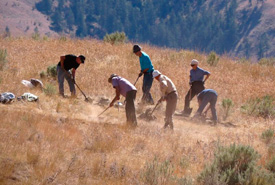
It's dusty work for volunteers completing newly dug artificial burrows at NCC's Sage and Sparrow Conservation Area (Photo by Dianne Bersea)
Other volunteers indicate a similar appreciation for getting out to do something different.
Melodie is keen on what she calls, “me-time in nature.” With a busy work and performance schedule as a dancer and dance teacher, visiting the owls is a restorative break.
For budding biologist Tyler, he’s building experience and a resume for future university applications. His mom Tracy, a volunteer and a vegetarian, values the work, even while dispensing the very non-vegetarian owl diet.
“I’m not squeamish. That’s what the owls eat. To support the owls sometimes we have to do the hard stuff,” she says.
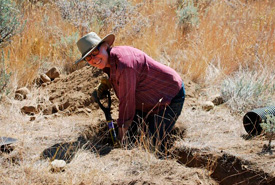
First-time volunteer Jodi Forster couldn't believe the beauty of BC's Sage and Sparrow (Photo by Dianne Bersea)
Corinne has a passion for birds and feels most at home working with wildlife. Eight years at a South Africa avian sanctuary provided lots of valuable experience. Corinne knows that whatever she contributes makes a difference.
“And I’m still good with a net and the mid-air catch!” she proclaims.
Burrowing owl contract field biologist and frequent volunteer, Lia McKinnon, is equally clear, and speaks for all the volunteers.
“This is a job I can feel good about. It’s a project moving in the right direction,” she says.
Lia enjoys handling the new hatches, affectionately known as "kids," and seeing them after they’ve fledged. Volunteer events are a way to have a direct experience of this wild bird that’s making a comeback thanks to the help of these amazing volunteers.
Interesting in volunteering to lend a hand to burrowing owls? Learn more about how you can help here.

